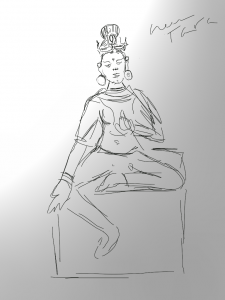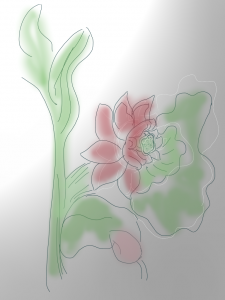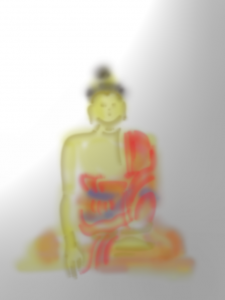Recently I facilitated an event where a colleague asked me what my vision for educational technology was for students in the museum. I have a wish list of items that I think students in our programs could really benefit from and I was quick to spit out my general want for laptops and multimedia software (I need 15 Macbooks!). My colleague was surprised and quickly shouted back:
“What about iPads? Laptops are so 2010! iPads are NOW! iPads are the FUTURE!”
I took a breath, quickly recited our Educational Mantra: Look Deeply, Think Deeply, Feel Deeply, and said, “okay…tell me more about that.”
He then explained that he is using an iPad lab at his school to engage students in drawing in galleries at another museum, utilizing drawing programs as an innovative way to sketch in the galleries.
I’m not skeptical about new technologies. I have an iPad, iPhone, Mac, netbook and graphics tablet, and have been working with technology for years. One of my first blogposts was about using personal mobile applications to enhance your visitor experience (for instance, I like using different photo software on my iPhone to take pictures in museums, but haven’t quite found an iPhone app for a museum that I really like). Programs that happen in schools are quite different from programs that can happen in museums, so I wanted to try out sketching with an iPad myself.
Using my iPad and a stylus, I ventured out into the galleries to try using the iPad as a sketchbook. Previous to this experience, I had purchased a moderately priced, and well reviewed “painting” program for the iPad called Artrage. There are other programs out there (I’m open to suggestions) and some are even free, but I felt that Art Rage seemed to have all if the things I was interested in, and various pencil settings for drawing and sketching.
The stylus I used was a Boxwave, and I have to admit, it’s a little pricey (@$15) and awkward. It is also my second attempt at using an iPad stylus as they are small and I lost the first one I purchased a few months ago (note to Educators with students who loose things- and Educators who loose small things). This type of stylus is different than something you would use on a Palm Pilot (remember those?) or Wacom Tablet, and it has a nubbed, rubber tip, to protect the iPad glass, so it’s not as precise as a pencil.
When I sketch in the galleries, I usually use a mechanical pencil and a fine grain paper. This was a trick I learned from an art teacher because I am rather heavy handed when it comes to pressing on paper. The mechanical pencil reminds me to work lightly so that I don’t break the lead. Adjusting to the stylus has been a bit difficult as I still can’t tell how the simulated pressure of the Artrage program works (and I’ve worked with it for at least 3 hours). This feeling might disappear over time, but for now, I felt that the stylus was quite “present-at-hand” vs. “ready-at-hand,” (to use Paul Dourish’s synthesis of Heidegger’s terminology when thinking about technology) meaning- I keep thinking about the stylus, instead of just using it.
I tried my hand at a few different objects in the gallery that I have sketched for the past year. My first attempt (probably a little ambitious) was the Green Tara in our Gateway to Himalayan Art exhibition:
 I worked on this rather quickly, and just couldn’t get the stylus tip to do what I wanted. The Artrage program allows you to zoom in and work on small details, as well as “undo” strokes that you mistakenly place on the screen. I guess this is like working with an eraser, but I constantly found myself navigating the computer program, the stylus, and the actual weight of the iPad (which is smaller than a 8 1/2 X 11 piece of paper, but much heavier). I’m not really happy with the sketching results, so I tried a few other things.
I worked on this rather quickly, and just couldn’t get the stylus tip to do what I wanted. The Artrage program allows you to zoom in and work on small details, as well as “undo” strokes that you mistakenly place on the screen. I guess this is like working with an eraser, but I constantly found myself navigating the computer program, the stylus, and the actual weight of the iPad (which is smaller than a 8 1/2 X 11 piece of paper, but much heavier). I’m not really happy with the sketching results, so I tried a few other things.
 This is a flower detail from a painting. I tried using a white pencil to draft the image, but still found the pencil application clunky. For variation I tried the airbrush tool to add color, which was a little more fun. We can only use dry media in the galleries which limits our work to color pencils, so it was interesting to add color, but not necessarily accurate to the depiction of the flower.
This is a flower detail from a painting. I tried using a white pencil to draft the image, but still found the pencil application clunky. For variation I tried the airbrush tool to add color, which was a little more fun. We can only use dry media in the galleries which limits our work to color pencils, so it was interesting to add color, but not necessarily accurate to the depiction of the flower.
 For my last attempt, I worked on an iconic painting of the Buddha, only using the airbrush feature and not the pencil. I actually found this to be an interesting exercise in matching color, though still had some issues with precision. I like the results of the airbrush exercise more than the sketching, and this exercise did help me to look deeply at color as I was less concerned about accuracy.
For my last attempt, I worked on an iconic painting of the Buddha, only using the airbrush feature and not the pencil. I actually found this to be an interesting exercise in matching color, though still had some issues with precision. I like the results of the airbrush exercise more than the sketching, and this exercise did help me to look deeply at color as I was less concerned about accuracy.
So……does an iPad and stylus replace a sketchpad and pencil. I don’t think it’s that simple.
We have to make sure that we use any tool (pencil, pen, marker, iPad, camera) appropriately in relation to the goals of the exercise. In my mind, the goal was to try and accurately illustrate what I was seeing, but this wasn’t happening based on either my inability to manipulate the software and tools that I was unfamiliar with or the tools themselves. Over time, I might get better at this, but with limited time in the galleries with students, this might not be the best option for sketching 1:1. When I changed my goal to experiment with color instead, I felt that I was accomplishing more, but it was a different type of activity. I think that the iPad is an additional multifaceted tool, not a replacement tool.
I would love to know if other people are experimenting with iPads as sketching/drawing tablets- or for in-gallery camera/film classes.



One Response to Will the iPad and stylus replace a sketchpad and pencil?